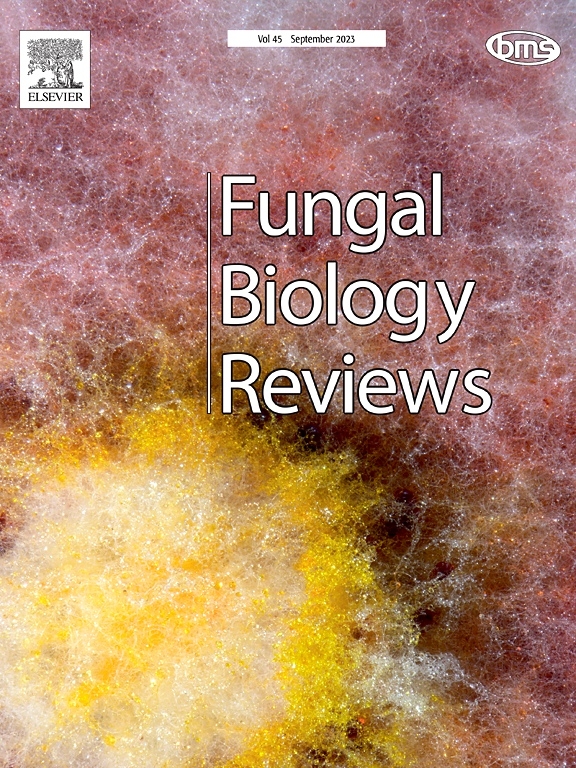通过基因工程增加昆虫病原真菌资源——一种自然和先发制人的害虫管理方法
IF 4.6
2区 生物学
Q1 MYCOLOGY
引用次数: 0
摘要
昆虫病原真菌在调节节肢动物种群中起着至关重要的作用,将它们定位为关键的控制剂。除了它们的主要功能外,这些真菌还具有多种功能,可以作为植物疾病的拮抗剂、植物内的内生菌、根际的定殖菌和植物生长的促进剂。它们的酶库包括各种酶,这些酶在蛋白酶和几丁质酶的协同作用下共同降解昆虫的角质层。改良昆虫病原真菌作为害虫控制工具的基因工程提供了前所未有的机会。这包括调整基因以更好地感染,针对特定的昆虫,表达强大的杀虫蛋白质。这为化学农药提供了一种更有效、更环保的替代品。这些真菌的遗传操作有助于提高它们的功效。增强这些真菌的致病性是通过基因干预实现的,包括编码神经毒性肽、蛋白酶、抗菌肽、角质层降解几丁质酶和影响昆虫生理的肽的基因。先发制人的害虫管理方法为解决农业和生态环境中与害虫相关的问题所带来的挑战提供了一种新颖而积极的范例。主动将生物防治剂纳入虫害综合管理方案正成为减少对合成化学品依赖的一种战略。作为害虫综合治理的一部分,应用从昆虫病原真菌中提取的纳米颗粒及其天然化合物是有希望的。这些创新与其他IPM组成部分相结合,可在不同的种植制度中提供卓越的功效。这些用于生物防治的真菌也需要严格的风险评估,以防止对有益昆虫的危害和生态破坏,特别是对传粉媒介。本文章由计算机程序翻译,如有差异,请以英文原文为准。

Enhancing entomopathogenic fungal resources through genetic engineering- A natural and pre-emptive approach to insect pest management
Entomopathogenic fungi assume a vital role in regulating arthropod populations, positioning them as pivotal agents of control. Beyond their primary function, these fungi exhibit versatility as antagonists to plant diseases, endophytes within plants, colonizers of the rhizosphere, and promoters of plant growth. Their enzymatic arsenal includes various enzymes that collectively degrade the insect cuticle, facilitated by the synergistic actions of proteases and chitinases. Genetic engineering to improve entomopathogenic fungi as pest control tools offers unprecedented opportunities. This involves tweaking genes for better infection, targeting specific insects and expressing powerful insect-killing proteins. This offers a more effective and eco-friendly alternative to chemical pesticides. Genetic manipulation of these fungi has been instrumental in enhancing their efficacy. Augmenting the pathogenicity of these fungi has been achieved through genetic interventions involving the incorporation of genes encoding neurotoxic peptides, proteases, antimicrobial peptides, chitinases for cuticle degradation, and peptides that influence insect physiology. The pre-emptive approach to insect pest management presents a novel and proactive paradigm for addressing the challenges posed by pest-related issues in both agricultural and ecological contexts. Integrating biological control agents proactively into integrated pest management protocols is emerging as a strategy to reduce dependence on synthetic chemicals. As a part of integrated pest management, the application of nanoparticles derived from entomopathogenic fungi, along with their natural compounds, holds promise. These innovations, when combined with other IPM components, offer superior efficacy across diverse cropping systems. These fungi used for biocontrol also need rigorous risk assessment to prevent harm to beneficial insects and ecological disruption, especially concerning pollinators.
求助全文
通过发布文献求助,成功后即可免费获取论文全文。
去求助
来源期刊

Fungal Biology Reviews
MYCOLOGY-
CiteScore
10.60
自引率
0.00%
发文量
36
期刊介绍:
Fungal Biology Reviews is an international reviews journal, owned by the British Mycological Society. Its objective is to provide a forum for high quality review articles within fungal biology. It covers all fields of fungal biology, whether fundamental or applied, including fungal diversity, ecology, evolution, physiology and ecophysiology, biochemistry, genetics and molecular biology, cell biology, interactions (symbiosis, pathogenesis etc), environmental aspects, biotechnology and taxonomy. It considers aspects of all organisms historically or recently recognized as fungi, including lichen-fungi, microsporidia, oomycetes, slime moulds, stramenopiles, and yeasts.
 求助内容:
求助内容: 应助结果提醒方式:
应助结果提醒方式:


